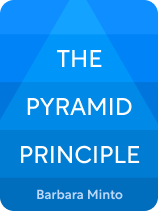

This article is an excerpt from the Shortform book guide to "The Pyramid Principle" by Barbara Minto. Shortform has the world's best summaries and analyses of books you should be reading.
Like this article? Sign up for a free trial here.
What is the Pyramid Writing style? Who invented this style of writing?
In her book The Pyramid Principle, Barbara Minto describes a new style of writing: Pyramid Writing. She claims it solves the problem of unclear writing by ensuring that you express your conclusions first.
Below we’ll share four goals you’ll accomplish when using the Pyramid Writing style.
Step 1: Write a Clear, Engaging Introduction
According to Minto, your piece should begin with a clear, engaging introduction so that your reader understands your conclusions within the first 30 seconds of reading. Minto argues that doing this of the Pyramid Writing style is polite: By providing your readers with a brief preview of your piece, you’re giving them the information they need to determine whether they should keep reading. For instance, imagine someone reading your composting email already believes she should compost. Once she reads your introduction, she’ll realize within the first 30 seconds that you agree; and from there, she may decide there’s no use reading a piece she already agrees with.
(Shortform note: How much can someone read in 30 seconds? Researchers estimate that adults’ average silent reading rate (the rate for reading in their heads) is 238 words per minute. An introduction that someone can read in 30 seconds should be close to half of that length: about 120 words. Most five-sentence paragraphs are close to that length. To respect your reader’s time, aim to explain your conclusions within a paragraph like this.)
Furthermore, Minto argues that you can make your introduction engaging by structuring it like a fictional story. Fictional stories typically have three parts: a beginning that sets the scene, a middle that introduces a problem, and an ending that resolves the problem. According to Minto, this structure works well for nonfiction introductions as well because it smoothly eases your reader toward your Peak Conclusion.
(Shortform note: Minto’s recommendation to enhance your introduction with techniques from fiction can be extended to other areas of your nonfiction piece as well. For example, you might apply the fiction-writing technique of building suspense to the title of your nonfiction piece. Fiction writers create suspense by leaving information out of their writing. Doing so plants questions in the reader’s mind and leaves them eager to discover the answers—so, they read on. To create suspense in your nonfiction piece’s title, drop a hint that there’s a problem without revealing the entire problem. Many of the most-read news articles feature suspenseful headlines that hint at a problem, such as “This is Why Uma Thurman is Angry.”)
Step 2: Order Ideas Logically
According to Minto, a second goal to work toward when writing is presenting your ideas in a logical order that reflects how they’re related. That way, your reader won’t have to expend mental energy or time determining how your ideas connect. First, decide which of your Tier 1 conclusions you’ll share first. Then, determine the order for each Tier 1 conclusion’s supporting ideas. Here are two options for how to order ideas:
Option 1: Action order. Share ideas in this order if one idea must happen before another, either because it must occur earlier in time or because it causes the idea that follows it. For instance, these three ideas are presented in action order: “The city will collect our organic waste, turn this waste into compost, and return the compost to us so we can garden with it.”
Option 2: Importance order. Alternatively, present your ideas in order of importance. Readers usually assume that ideas that come earlier in a sequence are more important.
(Shortform note: To help your readers follow the logical throughline of your ideas, consider using transition words and phrases. In On Writing Well, William Zinsser claims that transition words and phrases (such as “for example” and “finally”) show your reader how your ideas relate, which helps them follow your ideas’ logical order. If you’re expressing ideas in action order, use transition words such as “First” and “Next” to clarify that the ideas relate sequentially. For example: “First, the city will collect our organic waste. Then, they’ll turn this waste into compost. Finally, they’ll return the compost to us so we can garden with it.” If you’re expressing ideas in importance order, present the most crucial idea first and then use transition words such as “furthermore” and “additionally” to signal you’re moving on to another idea.)
Step 3: Make Your Organization Clear to Your Reader
Third, Minto argues that your writing must signpost the pyramid structure you brainstormed so that it’s easy for readers to identify your conclusions and follow your logic. Here are three tips for making your organization clear to readers:
Tip 1: Use hierarchical headings. According to Minto, this style of signposting uses distinct heading styles for each level in your pyramid, signaling to your reader when you’re moving onto a conclusion’s supporting ideas. For example, you could use large, uppercase letters to indicate the title of your piece, medium-font text to title each of your Tier 1 conclusions, and small-font text to title each of the headings for your Tier 2 ideas.
Tip 2: Make your conclusions easy to spot. Minto claims that you can do this by bolding or italicizing sentences that contain your conclusions.
Tip 3: Use nesting. This involves indenting a piece of text to indicate that it supports the conclusion above it. Bullet points are a common form of nesting.
Step 4: Craft a Motivating Conclusion
How do you end a conclusions-first piece of writing? Minto argues that you should end your piece with a new, motivating idea instead of simply restating your Peak Conclusion. A piece of Pyramid Writing doesn’t need a traditional concluding paragraph (in which you restate your main argument), since you’ve already shared your conclusions according to the conclusions-first approach. Instead, the best ending is one that presents a new idea: one that motivates your readers to either take your ideas seriously or take some sort of action.

———End of Preview———
Like what you just read? Read the rest of the world's best book summary and analysis of Barbara Minto's "The Pyramid Principle" at Shortform.
Here's what you'll find in our full The Pyramid Principle summary:
- How to write so clearly that you can get a point across within 30 seconds
- How to write a clear, compelling introduction, body, and conclusion
- Why you should always start your prose with your conclusion and work backward






